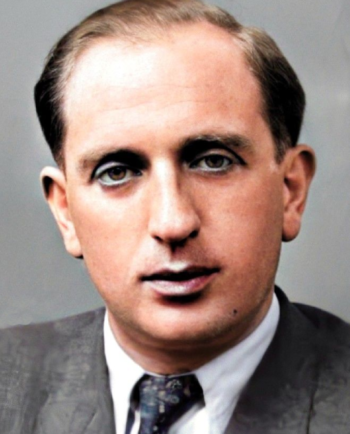Rajchman, Chil

Chil Rajchman (aka Henryk or Ye(c)hiel Reichman(n), 14 June 1914 – 7 May 2004) was a Polish Jew who was deported to the Treblinka Camp on 10 October 1942, from which he escaped after an inmate uprising on 2 August 1943. Still during the war, he presumably wrote down his experiences in Yiddish, which were then rewritten by a poet named Nachum Bomze. His version is the only one that survived and was later translated and published in various languages (English see Rajchman 2011). Rajchman was also interrogated by a Polish investigative commission on 12 October 1945, and he testified in U.S. proceedings leading to the extradition of John Demjanjuk, as well as during the Demjanjuk show trial itself. Finally, the United States Holocaust Memorial Museum conducted an interview with him in December 1988.
Here are some of the more peculiar claims by Rajchman:
- First, the air was sucked out of the gas chambers through thick pipes, then gas coming from an unspecified engine flowed into the chambers through showerheads. Once the “Germans conducted an experiment” by only creating a vacuum, but not adding any gas. After 48 hours, some victims were still alive. However, creating a vacuum in a brick-and-mortar building is technically impossible (the external pressure would crush the walls), hence most certainly was not done. It was also useless, since a hermetically sealed room packed tightly with people has sufficient oxygen only for a few hours at best. After 48 hours, no one could have been alive.
- In the smaller gas chambers (three according to his Polish interview), victims simply looked like they had fallen asleep peacefully. Yet being gassed with hot, stinking, smoking exhaust gasses would have allowed no one to sleep peacefully.
- In the larger gas chambers – described in his Polish interview as ten rooms each measuring 6 m × 6 m – the victims’ faces had turned completely black, while “their bellies were bloated and colored blue.” This is toxicological nonsense. While hot exhaust gases can lead to burns, these color the skin red, not black or blue. Carbon monoxide, the most-lethal ingredient in engine-exhaust gases, results in pink, even cherry-red discolorations. This shows that Rajchman (and/or Bomze) had never seen victims of engine-exhaust gassings.
- The mass graves were some ten meters deep, which surely is an exaggeration, considering the difficulties that would have been associated with such a depth, not least with intruding groundwater.
- The total surface area covered by the graves he claimed would have been larger than the area of the camp where he claimed these graves were located.
- The mass graves allegedly contained some 1.5 million corpses – twice as many bodies as Jews were ever deported to that camp.
- He claimed that 10,000 (or 15,000) people were killed at Treblinka daily from his arrival until mid-December of 1942. Hence, during just two months of his stay in the camp, some 600,000 to 900,000 people were killed, although documents show that only some 300,000 were deported there during that time.
- Starting in January 1943 (although the orthodoxy insists on March), exhumed corpses were put on a grate made of railway tracks 30 m long and 1.5 m wide and a half (or one and a half) meters off the ground. 2,500 bodies were placed on it, hence 83 per running meter. This is 20 times more than is possible as demonstrated by practical experiences during real-world open-air incinerations (4 to 5 corpses per running meter when using fresh wood as fuel). If placing three corpses per running meter in one layer of, say, 20 cm height, the pile would be (83/m÷3/m×0.2m=) five and a half meters high, not 2 meters, as Rajchman claimed. A pile one and a half meters wide and five and a half meters high would surely be unstable and topple over, particularly if set aflame and then inevitably burning unevenly.
- Fuel was added underneath the grate only after piling up the corpses! This is preposterous nonsense. In fact, in his Polish interview, he claimed that the corpses piled up on raised rails were simply lit from below.
- As fuel, they used “dry branches” in order to set the corpses on fire. Once ablaze, they evidently burned by themselves, yet the myth of self-immolating bodies is just that. Moreover, there would not have been enough space underneath the grates to add the actual firewood needed to burn the claimed load. In fact, only a few percent of the actual wood required could have been placed there.
- Since the Germans allegedly planned in 1943 (after Stalingrad!) to conquer Britain, they initiated plans to build a special incinerator in Treblinka for the British Jews. Such absurdity requires no comment.
- Last and best, Rajchman told this tale:
“At one time we put up a roast beside a large grave, into which more than 250,000 corpses had been thrown. The roast was loaded as usual and lit in the evening. There was a strong wind, and the fire burned so intensely, that it spread to the large opened grave. The blood from a quarter of a million human beings went up in flames and burned until the evening of the following day.
All of the leading camp staff came to take a look at this wonder. They marveled at this fantastic fire. The blood rose to the surface of the ground and ignited like fuel.”
Is it necessary to point out that blood, which is 90% water, is in no way comparable to gasoline?
(For more details, see Kues 2010; Mattogno 2021e, pp. 157f.)

You need to be a registered user, logged into your account, and your comment must comply with our Acceptable Use Policy, for your comment to get published. (Click here to log in or register.)